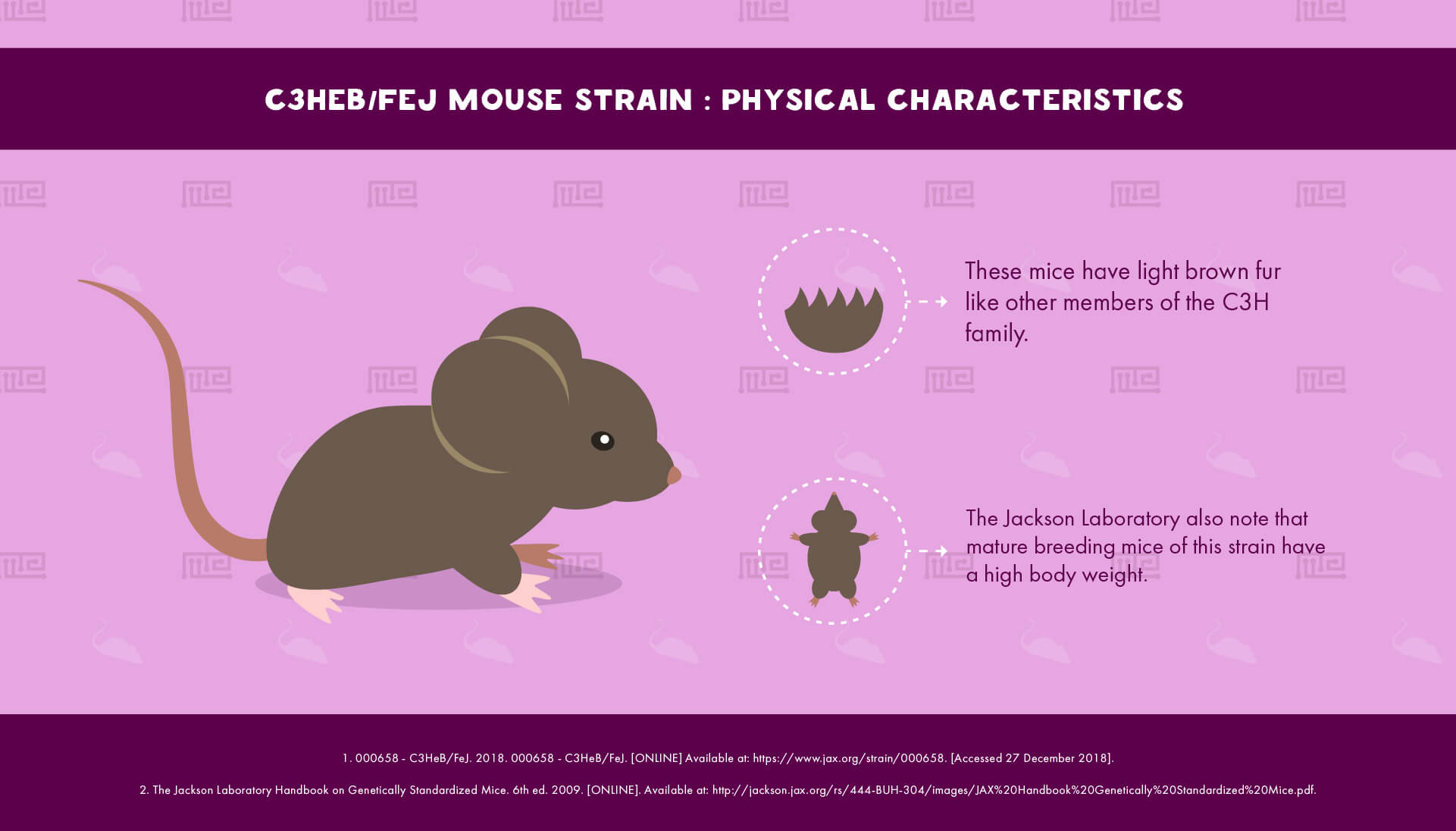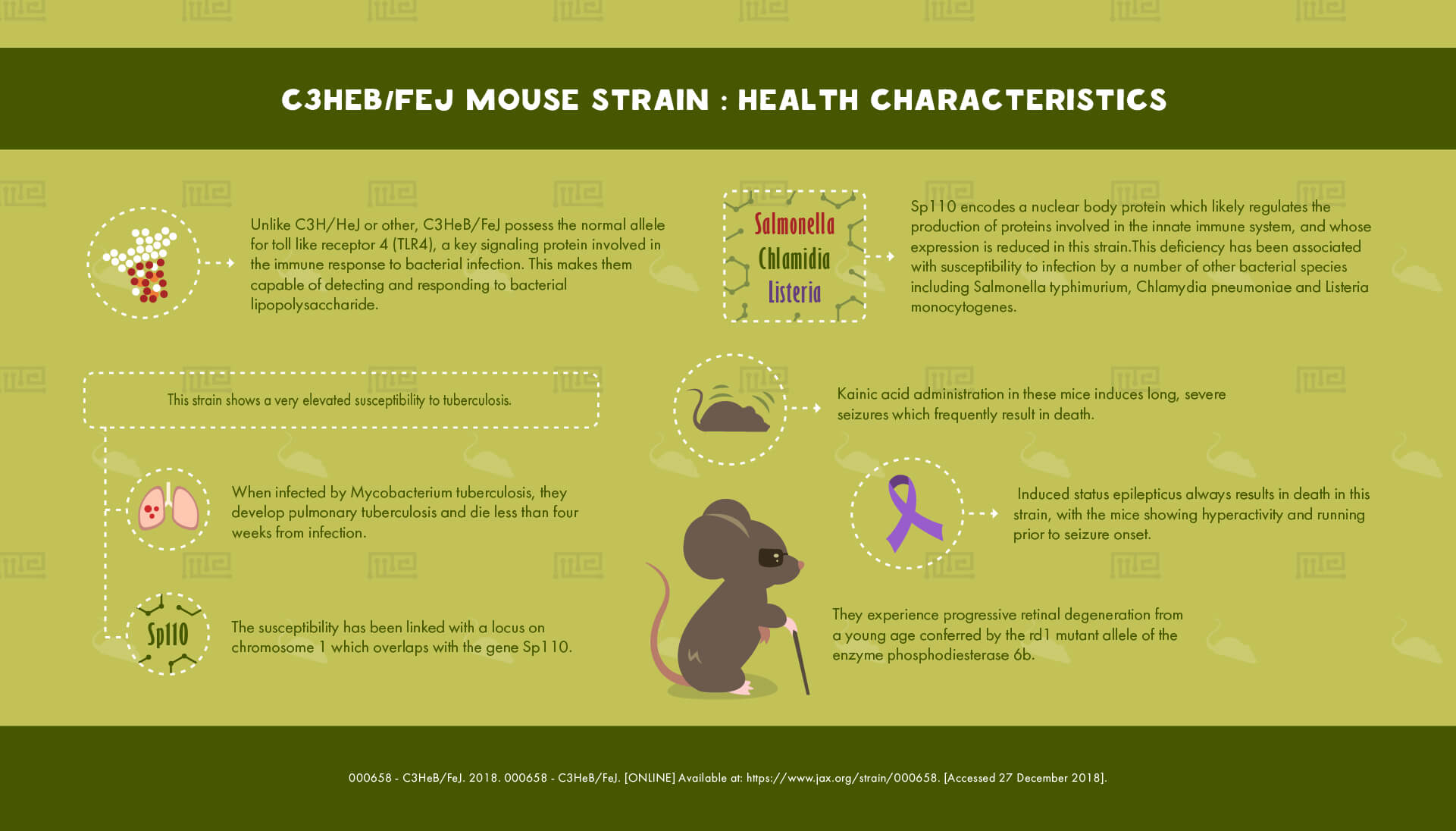History
The original C3H strain was developed by Strong in 1920 by crossing a DBA mouse with a Bagg albino. The C3H/He substrain is named for Heston, who acquired it in 1941, before passing it to the Jackson Laboratory in 1947, where it became C3H/HeJ.[2]
C3HeB/FeJ mice are derived from C3H/HeJ. In 1948 Fekete transferred a fertilized ovum from a female C3H/HeJ mouse to a C57BL/6J. The descendants of this transfer passed to Hummel and then to the JAX production facility in 1950.[2]
Behavioral Characteristics & Handling
The Jackson Laboratory handbook describes C3HeB/FeJ mice as “jumpy”,[3] implying that they are anxious but not aggressive. While this should not raise too much concern for researchers, those who require a highly docile strain may want to avoid C3HeB/FeJ.
C3HeB/FeJ spends a large amount of time in the open area of the open field test, suggesting they exhibit a low level of anxiety and a high preference for locomotion, although variance was high. This conclusion is confirmed by their performance in elevated zero maze, which is comparable to DBA/2J and 129/SvlmJ. However, they perform marginally worse than these two strains in the rotarod test.[4]
They are also described as good breeders and good parents.[3]
Health Characteristics
The health characteristics of C3HeB/FeJ mice differ from others in the same family as a result of a few important genetic loci. Most notably, unlike C3H/HeJ, C3HeB/FeJ possess the normal allele for toll-like receptor 4 (TLR4), a key signaling protein involved in the immune response to bacterial infection. These mice are thus capable of detecting and responding to bacterial lipopolysaccharide.
This strain shows a very elevated susceptibility to tuberculosis. When infected by Mycobacterium tuberculosis, they develop pulmonary tuberculosis and die less than four weeks from infection. The susceptibility has been linked with a locus on chromosome 1 which overlaps with the gene Sp110.
Sp110 encodes a nuclear body protein which likely regulates the production of proteins involved in the innate immune system, and whose expression is reduced in this strain. This deficiency has been associated with susceptibility to infection by a number of other bacterial species including Salmonella typhimurium, Chlamydia pneumoniae, and Listeria monocytogenes.
Kainic acid administration in these mice induces long, severe seizures which frequently result in death. Induced status epilepticus always results in death in this strain, with the mice showing hyperactivity and running prior to seizure onset.
Like many other inbred strains, C3HeB/FeJ possesses the rd1 mutant allele of the enzyme phosphodiesterase 6b, conferring progressive retinal degeneration from a young age.[1]
Major Experimental Uses
C3HeB/FeJ mice are of most interest in immunological research, especially focusing on immune deficiency, bacterial infection, inflammation, autoimmunity, and macrophage abnormalities. They can also be applied to the study of tuberculosis and retinal degeneration.[1]
References
- 000658 – C3HeB/FeJ. 2018. 000658 – C3HeB/FeJ. [ONLINE] Available at: https://www.jax.org/strain/000658. [Accessed 27 December 2018].
- MGI – Inbred Strains: C3H. 2018. MGI – Inbred Strains: C3H. [ONLINE] Available at: http://www.informatics.jax.org/inbred_strains/mouse/docs/C3H.shtml. [Accessed 27 December 2018].
- The Jackson Laboratory Handbook on Genetically Standardized Mice. 6th ed. 2009. [ONLINE]. Available at: http://jackson.jax.org/rs/444-BUH-304/images/JAX%20Handbook%20Genetically%20Standardized%20Mice.pdf.
- Lisa M. Tarantino, Thomas J. Gould, Jonathan P. Druhan, Maja Bucan. 2000. Behavior and mutagenesis screens: the importance of baseline analysis of inbred strains. Mammalian Genome. 11. 555–564.


